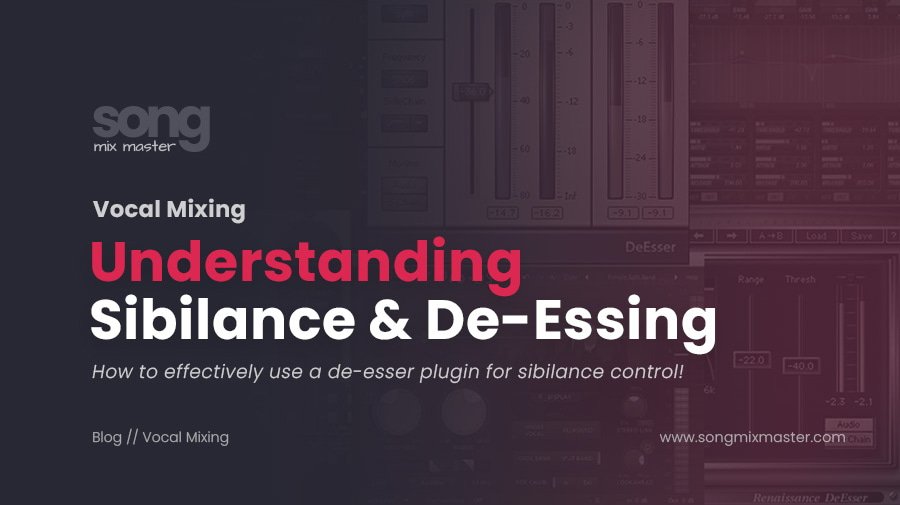Mixing
Understanding Sibilance and De-Essing in Vocal Mixing
Sibilance describes the sharp, hissy noises produced when a vocalist articulates consonants such as “s,” “z,” “sh,” “ch,” and “t.” These high-frequency sounds can become overwhelmingly prominent and distracting in a recording, mainly if the singer tends to sibilance or if the recording equipment, like microphones and preamps, accentuates these frequencies.
When left unchecked, excessive sibilance can render a vocal track harsh, tiresome, and unprofessional. Moreover, it can interfere with other mix elements, making achieving a cohesive and polished final product challenging.
The Nature of Sibilance
Sibilance typically occurs in the frequency range of 5 kHz to 10 kHz. This range is where our ears are most sensitive, which is why sibilance can be so jarring and unpleasant. Several factors contribute to sibilance in a recording:
- Vocalist’s Pronunciation: Some vocalists naturally produce more sibilant sounds.
- Microphone Choice: Condenser microphones, known for their sensitivity and high-frequency response, often exaggerate sibilance.
- Recording Environment: Reflective surfaces and poor acoustics can enhance high frequencies.
- Mic Technique: Close mic positioning can exacerbate sibilance, as the proximity effect emphasizes high frequencies.
The Impact of Sibilance
When sibilance is not properly managed, it can dominate a vocal track, making it difficult to balance with other elements in the mix. Harsh sibilant sounds can distract listeners and cause ear fatigue, leading to an unprofessional-sounding mix.
Moreover, excessive sibilance can interfere with other high-frequency elements in the mix, such as cymbals and high-hats, creating a cluttered and unbalanced soundscape.
The Role of De-Essing
Lessing is the process of reducing these harsh sibilant frequencies to improve the vocal’s placement in the mix without making it dull or muffled. This technique involves identifying the problematic frequencies and applying dynamic processing to tame them.
The first step in de-essing is identifying the specific frequencies that must be addressed. This can be done using:
- Spectral Analysis: Visual tools like spectrograms can help pinpoint the exact frequency ranges where sibilance occurs.
- Auditory Identification: Listening critically to the vocal track and noting the harsh sibilant sounds.
There are several methods and tools used for de-essing, each with its strengths and weaknesses:
- Manual EQ Adjustments: Using an equalizer to reduce the gain in the sibilant frequency range manually. This method requires precision and can sometimes lead to a loss of clarity in the vocal.
- Dynamic EQ: A dynamic EQ automatically reduces the gain in the specified frequency range when sibilance is detected, allowing for more targeted and subtle easing.
- De-Esser Plugins: Specialized plugins designed to detect and reduce sibilance. These plugins typically offer threshold, frequency range, and reduction amount controls, allowing for precise adjustments. Some advanced de-essers, like the Antares Vocal De-Esser, use AI to adapt to the vocal performance dynamically.
Applying De-Essing

De-esser plugins have come a long way, offering advanced features and intuitive interfaces to help audio engineers and producers tame those harsh, hissy sounds without compromising the vocal’s natural tone.
Here’s a look at the best de-esser plugins you should consider for de-essing:
- Antares Vocal De-Esser – AI-powered sibilance control for precise and dynamic de-essing.
- FabFilter Pro-DS – Highly intuitive interface with excellent detection and reduction capabilities.
- Waves Sibilance – Real-time de-essing with patented Organic ReSynthesis technology.
- iZotope RX De-ess – Advanced spectral shaping for transparent sibilance reduction.
- Slate Digital FG-DS – Versatile and easy-to-use de-esser with precise control.
Also, check my complete list of 15 Best De-Esser Plugins For Better Sibilance Control
When applying de-essing, it’s essential to strike a balance. Over-de-essing can make the vocal sound dull and lifeless, while under-de-essing can leave the harsh sibilant sounds intact.
Here are some tips on how to use any de-esser plugin:
- Set the Threshold: Adjust the threshold so only the sibilant peaks trigger the de-esser.
- Choose the Frequency Range: Focus on the specific frequency range where sibilance occurs, typically between 5 and 10 kHz.
- Adjust the Reduction Amount: Apply just enough reduction to tame the sibilance without affecting the vocal’s overall clarity.
Practical Approach
First, we’ll listen to the vocal track to understand our issue, which in this case is mainly excessive sibilance from the “S” and “T” consonants. Next, we’ll find the best technique or tool to solve the problem.
For more advanced control, consider using multiband compression or sidechain compression to target sibilance. These techniques allow for greater flexibility and precision in managing high-frequency content.
Remember, vocal de-esseing isn’t about “a trick that always works”. It’s a methodological approach based on the sound engineer’s listening and audio-mixing skills.
If you’re struggling with sibilance issues or need a complete mix and master, our team of experienced engineers is here to help. Check out our professional audio mixing and mastering services.


Disclaimer: Any references to any brands on this website/webpage, including reference to products, trademarks, brands and companies, are provided for description purposes only. We don't have any association with or endorsement by these brands or companies. Some of the links on our blog may be affiliate links. This means if you click on these links and make a purchase, we may earn a commission at no extra cost to you.
Check Out My New Fabfilter Pro-Q3 Presets Pack!
You may also like to read...
Learn How Audio Saturation Can Improve Your Mixes
Bass Mixing – Best Tips & Plugins To Enhance Your Bass
5 Essential Tips for Mixing on Headphones
Analog Gear vs. Digital Audio Plugins in Mixing and Mastering
Review: Scaler EQ by Plugin Boutique – The Harmonic Master
7 Steps to the Perfect Mix in Hip-Hop, Techno, Rock, and Pop
Book My Mixing & Mastering Services